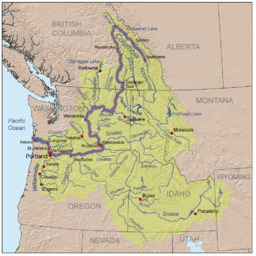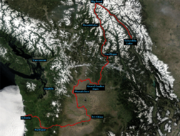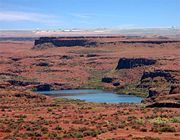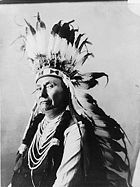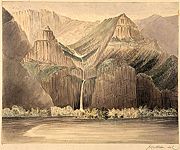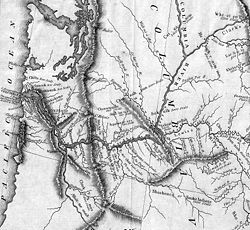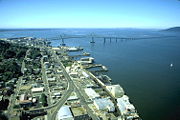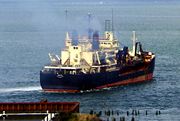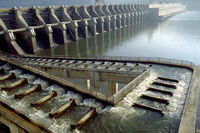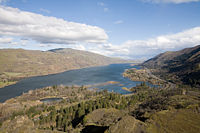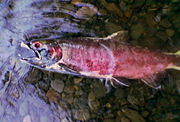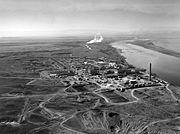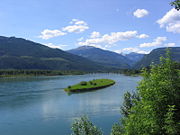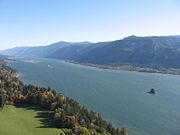Columbia River
2008/9 Schools Wikipedia Selection. Related subjects: North American Geography
| Columbia River | |
| River | |
|
Bonneville Dam, in the Columbia River Gorge
|
|
| Countries | Canada, United States |
|---|---|
| States | Washington, Oregon |
| Provinces | British Columbia |
| Tributaries | |
| - left | Spillimacheen River, Beaver River, Illecillewaet River |
| - right | Kicking Horse River, Blaeberry River, Canoe River, Kettle River, Sanpoil River, Okanogan River, Yakima River, Cowlitz River |
| Cities | Revelstoke, BC, Tri-Cities, WA, Portland, OR, Vancouver, WA |
| Source | Columbia Lake |
| - location | British Columbia, Canada |
| - elevation | 2,690 ft (820 m) |
| - coordinates | |
| Mouth | Pacific Ocean |
| - elevation | 0 ft (0 m) |
| - coordinates | |
| Length | 1,243 mi (2,000 km) |
| Basin | 258,000 sq mi (668,217 km²) |
| Discharge | mouth |
| - average | 265,000 cu ft/ s (7,504 m³/ s) |
| - max | 1,240,000 cu ft/ s (35,113 m³/ s) |
| - min | 12,100 cu ft/ s (343 m³/ s) |
The Columbia River (known as Wimahl or Big River to the Chinook-speaking natives who live on its lowermost reaches) is the largest river in the Pacific Northwest region of North America. It is named after the Columbia Rediviva, the first ship from the western world known to have traveled up the river. It stretches from the Canadian province of British Columbia through the U.S. state of Washington, forming much of the border between Washington and Oregon before emptying into the Pacific Ocean. The river is 1,243 miles (2,000 km) long, and its drainage basin is 258,000 square miles (670,000 km²).
Measured by the volume of its flow, the Columbia is the largest river flowing into the Pacific from North America and is the fourth-largest river in the United States. The river's heavy flow, and its large elevation drop over a relatively short distance, give it tremendous potential for the generation of electricity. It is the largest hydroelectric power producing river in North America with fourteen hydroelectric dams in the United States and Canada.
The Columbia and its tributaries are home to numerous anadromous fish, which migrate between small fresh water tributaries of the river and the Pacific Ocean. These fish—especially the various species of salmon—have been a vital part of the river's ecology and the local economy for thousands of years.
The taming of the river for human use, and the industrial waste that resulted in some cases, have come into conflict with ecological conservation numerous times since Americans and Europeans began to settle the area in the 18th century. This "harnessing", as it was commonly described in the popular culture of the early 20th century, included dredging for navigation by larger ships, nuclear power generation and nuclear weapons research and production, and the construction of dams for power generation, irrigation, navigation, and flood control.
Drainage basin
With an average annual flow of about 265 thousand cubic feet per second (7.5×103 m3/s), the Columbia is the largest river by volume flowing into the Pacific from North America and is the fourth-largest by volume in the United States. Ranked by size of drainage basin and length, the Columbia is sixth- and twelfth-largest in the U.S., respectively. The Columbia's highest recorded flow, measured at The Dalles, Oregon, was 1.24 million cubic feet per second (35×103 m3/s) in June 1894. The river flows 1,243 miles (2,000 km) from its headwaters to the Pacific and drains an area of about 260,000 square miles (670,000 km²). The river's drainage basin covers nearly all of Idaho, large portions of British Columbia, Oregon, and Washington, and small portions of several neighboring states. Roughly 85 percent of the drainage basin and 745 miles (1,200 km) of the river's length are in the United States.
Columbia Lake, elevation 2,690 feet (820 m) and the adjoining Columbia Wetlands form the Columbia’s headwaters in the southern Rocky Mountain Trench, a broad, deep and very long glacial valley running between the Canadian Rockies and Columbia Mountains in British Columbia (the province derives its name, indirectly, from the river). For its first 200 miles (320 km), the Columbia flows northwest along the Trench through Windermere Lake and the town of Invermere, a region known in British Columbia as the Columbia Valley then northwest to Golden and into Kinbasket Lake. Rounding the northern end of the Selkirk Mountains,, the river then turns sharply south through a region known as the Big Bend Country, passing through Revelstoke Lake and the Arrow Lakes; Revelstoke, the Big Bend and the Columbia Valley combined are referred to in BC parlance as the Columbia Country. Below the Arrow Lakes, the Columbia passes the cities of Castlegar, located at the Columbia's confluence with the lower Kootenay River, and Trail, two major centres of the West Kootenay region. The Pend Oreille River joins the Columbia about 2 miles (3 km) north of the U.S.–Canada border.
The Columbia enters eastern Washington flowing southwest. It marks the southern and eastern borders of the Colville Indian Reservation and the western border of the Spokane Indian Reservation before turning south and then southeasterly near the confluence with the Wenatchee River in central Washington. This C-shaped segment of the river is also known as the "Big Bend". During the Missoula Floods, 10,000 to 15,000 years ago, much of the floodwaters took a more direct route south, forming the Grand Coulee. After the floods, the river found its present course, and the Grand Coulee was left dry. The construction of the Grand Coulee Dam in the mid-20th century backed the river up into the dry coulee, forming the reservoir of Banks Lake.
The river flows past The Gorge Amphitheatre, a prominent concert venue in the Northwest, and then past the Hanford Nuclear Reservation. The Snake River joins the Columbia in the Tri-Cities area. Hanford Reach, a section of the Columbia between Priest Rapids Dam and the Tri-Cities, is the only American stretch of the river that is free-flowing, unimpeded by dams, and not a tidal estuary. The Columbia makes a sharp bend to the west at the Washington–Oregon border. The river defines that border for the final 309 miles (497 km) of its journey.
Between The Dalles and Portland, the river cuts through the Cascade Mountains, forming the dramatic Columbia River Gorge. Along with the Klamath River in southern Oregon and the Pit River in northern California, the Columbia is one of only three rivers to pass through the Cascades. The gorge is known for its strong and steady winds, scenic beauty, and its role as an important transportation link.
The river continues west, bending sharply to the north-northwest between Portland and Vancouver, Washington, at the river's confluence with the Willamette River. Here the river slows considerably, dropping sediment that might otherwise form a river delta. The Columbia empties into the Pacific Ocean just past Astoria, Oregon, over the Columbia Bar, a shifting sandbar that makes the river's mouth one of the most hazardous stretches of water to navigate in the world.
Geology
Volcanic activity in the region has been traced to 40 million years ago, in the Eocene era, forming much of the landscape traversed by the Columbia. In the Pleistocene era (the last ice age, two million to 700,000 years ago), the river broke through the Cascade Range, forming the Columbia River Gorge.
The river and its drainage basin experienced some of the world’s greatest known floods toward the end of the last ice age. The periodic rupturing of ice dams at Glacial Lake Missoula resulted in discharge rates ten times the combined flow of all the rivers of the world, as many as forty times over a thousand-year period.
Water levels during the Missoula Floods have been estimated at 1,250 feet (380 m) at the Wallula Gap, 830 feet (250 m) at Bonneville Dam, and 400 feet (120 m) over modern Portland, Oregon. The floods' periodic inundation of the lower Columbia River Plateau deposited rich lake sediments, establishing the fertility that supports extensive agriculture in the modern era. They also formed many unusual geological features, such as the channeled scablands of eastern Washington.
The river was blocked by the collapse of a mountain on the north side of the Columbia River Gorge, likely a result of the Cascadia earthquake in 1700, in an event known as the Bonneville Slide. The resulting land bridge blocked the river until rising waters tunneled through and finally washed away the sediment. In 1980, the eruption of Mount St. Helens deposited large amounts of sediment in the lower Columbia, temporarily reducing the depth of the shipping channel by 25 feet (7.6 m)
Indigenous peoples
Humans have inhabited the Columbia River Basin for more than 15,000 years, with a transition to a sedentary lifestyle based mainly on salmon starting about 3,500 years ago. In 1962, archaeologists found evidence of human activity dating back 11,230 years at the Marmes Rockshelter, near the confluence of the Palouse and Snake rivers in eastern Washington. In 1996, the skeletal remains of a 9,000-year-old prehistoric man (dubbed Kennewick Man) were found near Kennewick, Washington. The discovery rekindled debate in the scientific community over the origins of human habitation in North America and sparked a protracted controversy over whether the scientific or Native American community was entitled to possess and/or study the remains.
Numerous different Native American and First Nations tribes have a historical and continuing presence on the Columbia. The Sinixt or Lakes people lived on the lower stretch of the Canadian portion (also claimed as part of Okanagan territory) the Secwepemc, Ktunaxa and at one time the Blackfoot on the upper; the Colville, Spokane, Yakama, Nez Perce, Umatilla, and the Confederated Tribes of Warm Springs live along the U.S. stretch. Along the upper Snake River and Salmon River, the Shoshone Bannock Tribes are present. Near the lower Columbia River, the Cowlitz and Chinook tribes, which are not federally recognized, are present. The Yakama, Nez Perce, Umatilla, and Warm Springs tribes all have treaty fishing rights along the Columbia and its tributaries.
Perhaps a century before Europeans began to explore the Pacific Northwest, the Bonneville Slide created a land bridge in the Columbia Gorge, known to natives as the Bridge of the Gods. The bridge was described as the result a battle between gods, represented by Mount Adams and Mount Hood, vying for the affection of a goddess, represented by Mount St. Helens. The bridge permitted increased interaction and trade between tribes on the north and south sides of the river until it was finally washed away.
The Cascades Rapids of the Columbia River Gorge, and Kettle Falls and Priest Rapids in eastern Washington, were important fishing and trading sites submerged by the construction of dams. The Confederated Tribes of Warm Springs, a coalition of various tribes, adopted a constitution and incorporated after the 1938 completion of the Bonneville Dam flooded Cascades Rapids.
For 11,000 years, Celilo Falls was the most significant economic and cultural hub for native peoples on the Columbia. It was located east of the modern city of The Dalles. An estimated 15 to 20 million salmon passed through the falls every year, making it one of the greatest fishing sites in North America. The falls were strategically located at the border between Chinookan and Sahaptian speaking peoples and served as the centre of an extensive trading network across the Pacific Plateau. It was the oldest continuously inhabited community on the North American continent until 1957, when it was submerged by the construction of The Dalles Dam and the native fishing community was displaced. The affected tribes received a $26.8 million settlement for the loss of Celilo and other fishing sites submerged by the Dalles Dam. The Confederated Tribes of Warm Springs used part of its $4 million settlement to establish the Kah-Nee-Tah resort south of Mount Hood.
New waves of explorers
Some historians believe that Japanese or Chinese vessels blown off course reached the Northwest Coast long before Europeans, possibly as early as 219 B.C. It is unknown whether they landed near the Columbia. There is some evidence that Spanish castaways reached the shore in 1679 and traded with the Clatsop; if these were indeed the first Europeans to see the Columbia, they never managed to send word home to Spain.
The first documented European discovery of the Columbia River was that of Bruno de Heceta, who in 1775 sighted the river's mouth. On the advice of his officers, he did not explore it, as he was short-staffed and the current was strong. He considered it a bay, and called it Ensenada de Asunción. Later Spanish maps based on his discovery showed a river, labeled Rio de San Roque, or an entrance, called Entrada de Hezeta.
Following Heceta's reports, British fur trader Captain John Meares searched for the river in 1788, but he misread the currents and concluded that the river did not exist. Royal Navy commander George Vancouver sailed past the mouth in April 1792 and observed a change in the water's colour, but he accepted Meares' report and continued on his journey northward. Later that month, Vancouver encountered the American captain Robert Gray at the Strait of Juan de Fuca. Gray reported that he had seen the entrance to the Columbia and planned to sail into it.
On May 12, 1792, Gray returned south and crossed the Columbia Bar, becoming the first explorer to enter the river. Gray's fur trading mission had been financed by Boston merchants, who outfitted him with a private vessel named Columbia Rediviva; he named the river after the ship on May 18.
In October 1792, Vancouver sent Lieutenant William Robert Broughton, his second-in-command, up the river. Broughton sailed up for some miles, and then his company continued in small boats. He got as far as the Columbia River Gorge, about 100 miles (160 km) upstream, sighting and naming Mount Hood, as well as Point Vancouver, near the present-day city of Vancouver, Washington. Broughton formally claimed the river, its watershed, and the nearby coast for Britain (which Gray had not done on hehalf of the United States).
Explorers had long speculated about the existence of a Northwest Passage or a great River of the West connecting the Atlantic Ocean to the Pacific, and some mapmakers depicted it on their maps. As the Columbia was at the same latitude as the headwaters of the Missouri River, they now concluded that Gray and Vancouver had discovered the Northwest Passage. A 1798 British map showed a dotted line connecting the Columbia with the Missouri. However, when the American explorers Meriwether Lewis and William Clark charted the vast, unmapped lands of the American West in their overland expedition (1803-05), they found no passage between the rivers. After crossing the Rocky Mountains, Lewis and Clark built dug-out canoes and paddled down the Snake River, reaching the Columbia at the confluence near the present-day Tri-Cities, Washington. They explored a few miles upstream as far as Bateman Island before heading down the Columbia, concluding their journey at the river's mouth and establishing Fort Clatsop.
Canadian explorer David Thompson, of the North West Company, spent the winter of 1807–08 at Kootenae House near the source of the Columbia at present-day Invermere, British Columbia. In 1811, he traveled down the Columbia to the Pacific Ocean, becoming the first European-American to travel the entire length of the river, arriving just after John Jacob Astor's Pacific Fur Company had founded Astoria.
In 1825, on behalf of the Hudson's Bay Company, Dr. John McLoughlin established Fort Vancouver (currently Vancouver, Washington) on the banks of the Columbia as a fur trading headquarters in the company's Columbia District. The fort was by far the largest European settlement in the northwest at the time. Every year ships would come from London (via the Pacific) to drop off supplies and trade goods in exchange for the furs. For many settlers the fort became the last stop on the Oregon Trail to buy supplies and land before starting their homestead. Because of its access to the Columbia River, Fort Vancouver’s influence reached from Alaska to California and from the Rocky Mountains to the Hawaiian Islands.
The earliest French Canadian employees of the North West Company called the Columbia River Ouragan (translation: "hurricane"), which is one of several plausible origins of the name "Oregon".
The United States and Britain agreed in 1818 to settle the Oregon Country jointly. Americans generally settled south of the river, while British fur traders generally settled to the north. The Columbia was considered a possible border in the boundary dispute that ensued, but ultimately the Oregon Treaty of 1846 established the boundary at the 49th parallel. The river later came to define most of the border between the U.S. territories of Oregon and Washington. Oregon became a U.S. state in 1857, Washington in 1889.
By the turn of the 20th century, the difficulty of navigating the Columbia was seen as an impediment to the economic development of the Inland Empire region east of the Cascades. The dredging and dam building that followed would permanently alter the river, disrupting its natural flow but also providing electricity, irrigation, navigability and other benefits to the region.
Navigation
American captain Robert Gray and British captain George Vancouver, who explored the river in 1792, proved that it was possible to cross the Columbia Bar. But the challenges associated with that feat remain today; even with modern engineering alterations to the mouth of the river, the strong currents and shifting sandbar make it dangerous to pass between the river and the Pacific Ocean.
The use of steamboats along the river, beginning in 1850, contributed to the rapid settlement and economic development of the region. Steamboats operated in several places: on the river's lower reaches, from the Pacific Ocean to Cascades Rapids, from the Cascades to Celilo Falls, and from Celilo to the confluence with the Snake River; on the Wenatchee Reach of eastern Washington; on British Columbia's Arrow Lakes; and on tributaries like the Willamette, the Snake and Kootenay Lake. The boats, initially powered by burning wood, carried both passengers and freight throughout the region for many years. Railroads served to connect steamboat lines where interrupted by waterfalls on the river's lower reaches. In the 1880s, railroads maintained by companies such as the Oregon Railroad and Navigation Company and the Shaver Transportation Company began to supplement steamboat operations as the major transportation links along the river.
Opening the passage to Lewiston
As early as 1881, industrialists proposed altering the natural channel of the Columbia to improve navigation. Changes to the river over the years have included the construction of jetties at the river's mouth, dredging, and the construction of canals and navigation locks. Today, ocean freighters can travel upriver as far as Portland and Vancouver, and barges can reach as far inland as Lewiston, Idaho.
The Columbia Bar, a shifting sandbar at the mouth of the river, makes passage between the river and the Pacific Ocean difficult and dangerous, and numerous rapids along the river hinder navigation. Jetties, first constructed in 1886, extend the river's channel into the ocean. Strong currents and the shifting sandbar remain a threat to ships entering the river and necessitate continuous maintenance of the jetties.
In 1891 the Columbia was dredged to enhance shipping. The channel between the ocean and Portland and Vancouver was deepened from 17 feet (5.2 m) to 25 feet (7.6 m) The Columbian newspaper called for the channel to be deepened to 40 feet (12 m) as early as 1905, but that depth was not attained until 1976.
Navigation locks were first constructed in 1896 around the Cascades Rapids, enabling boats to travel safely through the Columbia River Gorge. The Celilo Canal, bypassing Celilo Falls, opened to river traffic in 1915. In the mid-20th century, the construction of dams along the length of the river submerged the rapids beneath a series of reservoirs. An extensive system of locks allowed ships and barges to pass easily from one reservoir to the next. A navigation channel reaching to Lewiston, Idaho, along the Columbia and Snake Rivers, was completed in 1975. One of the main commodities is wheat, mainly for export. More than 40 percent of all US wheat exports are barged on the Columbia River.
The 1980 eruption of Mount St. Helens caused mudslides in the area, which reduced the Columbia's depth by 25 feet (7.6 m) for a 4-mile (6.4 km) stretch, disrupting Portland's economy.
Deeper shipping channel
Efforts to maintain and improve the navigation channel have continued to the present day. In 1990, a new round of studies examined the possibility of further dredging on the lower Columbia. The plans were controversial from the start because of economic and environmental concerns.
In 1999, Congress authorized deepening the channel between Portland and Astoria from 40 feet (12 m) to 43 feet (13 m), which will make it possible for large container and grain ships to reach Portland and Vancouver. The project includes measures to mitigate environmental damage; for instance, for every acre (4,000 m²) of wetland damaged by the project, the U.S. Army Corps of Engineers must restore 12 acres (49,000 m²) of wetland. However, it has met opposition due to concerns about stirring up toxic sediment on the riverbed. Portland-based Northwest Environmental Advocates brought a lawsuit against the Army Corps of Engineers, but it was rejected by the 9th U.S. Circuit Court of Appeals in August 2006. In early 2006, the Corps spilled 50 US gallons (190 L) of hydraulic oil into the Columbia, drawing further criticism from environmental organizations.
Work on the project began in 2005 and is expected to conclude in 2010. The project's cost is estimated at $150 million. The federal government is paying 65 percent, Oregon and Washington are paying $27 million each, and six local ports make payments as well.
Dams: harnessing the river
| This river may have been shaped by God, or glaciers, or the remnants of the inland sea, or gravity or a combination of all, but the Army Corps of Engineers controls it now. The Columbia rises and falls, not by the dictates of tide or rainfall, but by a computer-activated, legally-arbitrated, federally-allocated schedule that changes only when significant litigation is concluded, or a United States Senator nears election time. In that sense, it is reliable. Timothy Egan, in The Good Rain |
In 1902, the United States Bureau of Reclamation was established to aid in the economic development of arid western states. One of its major undertakings was building Grand Coulee Dam to provide irrigation for the 600,000 acres (2,400 km²) of the Columbia Basin Project in central Washington. With the onset of World War II, the focus of dam construction shifted to production of hydroelectricity. Irrigation efforts resumed after the war.
River development occurred within the structure of the 1909 International Boundary Waters Treaty between the U.S. and Canada. In the 1960s, the United States and Canada signed the Columbia River Treaty. Canada agreed to build dams and provide reservoir storage, and the U.S. agreed to deliver to Canada one-half of the increase in U.S. downstream power benefits as estimated five years in advance. Canada's obligation was met by building three dams (two on the Columbia, and one on the Duncan River), the last of which was completed in 1973.
Today, the main stem of the Columbia River has 14 dams (3 in Canada, 11 in the U.S.) Four mainstem dams and four lower Snake River dams contain navigation locks to allow ship and barge passage from the ocean as far as Lewiston, Idaho. The river system as a whole has over 400 dams for hydroelectricity and irrigation. The dams address a variety of demands, including flood control, navigation, stream flow regulation, storage and delivery of stored waters, reclamation of public lands and Indian reservations, and the generation of hydroelectric power.
The larger U.S. dams are owned and operated by the federal government (some by the Army Corps of Engineers and some by the Bureau of Reclamation), while the smaller dams are operated by public utility districts, and private power companies. The federally operated system is known as the Federal Columbia River Power System, which includes 31 dams on the Columbia and its tributaries. The system has altered the seasonal flow of the river in order to meet higher electricity demands during the winter. At the beginning of the 20th century, roughly 75 percent of the Columbia's flow occurred in the summer, between April and September. By 1980, the summer proportion had been lowered to about 50 percent, essentially eliminating the seasonal pattern.
The installation of dams dramatically altered the landscape and ecosystem of the river. At one time, the Columbia was one of the top salmon-producing river systems in the world. Previously active fishing sites, most notably Celilo Falls in the eastern Columbia River Gorge, have exhibited a sharp decline in fishing along the Columbia in the last century, and salmon populations have been dramatically reduced. Fish ladders have been installed at some dam sites to help the fish journey to spawning waters. Chief Joseph Dam has no fish ladders and completely blocks fish migration to the upper half of the Columbia River system.
Irrigation
The Bureau of Reclamation's Columbia Basin Project focused on the generally dry Columbia River Basin, which features rich loess soil deposited by the Missoula Floods. Several groups developed competing proposals, and in 1933, President Franklin D. Roosevelt authorized the Columbia Basin Project. The Grand Coulee Dam was the project's central component; upon completion, it pumped water up from the Columbia to fill the formerly dry Grand Coulee, forming Banks Lake. By 1935, the intended height of the dam was increased from a range between 200 feet (61 m) and 300 feet (91 m) to 500 feet (150 m), a height that would extend the lake impounded by the dam all the way to the Canadian border; the project had grown from a local New Deal relief measure to a major national project.
The project's initial purpose was irrigation, but the onset of World War II created a high demand for electricity, mainly for aluminium production and for the development of nuclear weapons at the Hanford Site. (See next section.) Irrigation began in 1951. The project provides water to more than 500,000 acres (2,000 km²) of fertile but arid lands in central Washington State. Water from the project has transformed the region from a wasteland barely able to produce subsistence levels of dry-land wheat crops to a major agricultural centre. Important crops include apples, potatoes, alfalfa, wheat, corn (maize), barley, hops, beans, and sugar beets.
Since 1750, the Columbia has experienced six multi-year droughts, much more severe than any in recent memory. The longest, in the mid-1800s, lasted 12 years, with the river's flow dropping 20 percent below average. Scientists have expressed concern over what such a drought could do to the today's regional economy, with its heavy reliance on the Columbia. In 1992–93, a lesser drought impacted farmers, hydroelectric power producers, shippers, and wildlife managers.
Many farmers in central Washington build dams on their property for irrigation and to control frost on their crops. The Washington Department of Ecology, using new techniques involving aerial photographs, estimated there may be as many as 100 such dams in the area, most of which are illegal. Six such dams have failed in recent years, causing hundreds of thousands of dollars of damage to crops and public roads. 14 farms in the area have gone through the permitting process to build such dams legally.
Hydroelectricity
The Columbia's heavy flow and extreme elevation drop over a short distance, 2.16 feet per mile (0.41 m/ km), give it tremendous capacity for hydroelectricity generation. In comparison, the Mississippi drops less than 0.65 feet per mile (0.12 m/ km). The Columbia alone possesses a third of the United States's hydroelectric potential.
The largest of the 150 hydroelectric projects, the Grand Coulee Dam and the Chief Joseph Dam, are also the largest in the United States and among the largest in the world.
Inexpensive hydro-power supported the emergence of an extensive aluminium industry, which draws tremendous amounts of power. Until 2000, the Northwestern United States produced up to 40 percent of the aluminum produced in the U.S., and 17 percent of the world's aluminium. But the commoditization of power in the early 2000s, coupled with drought that reduced the generation capacity of the river, damaged the industry; by 2003, the U.S. produced only 15 percent of the world's aluminium, many smelters among the Columbia having gone dormant or having gone out of business.
Power remains relatively inexpensive along the Columbia, and in recent years high-tech companies like Google have begun to move server farm operations into the area to avail themselves of cheap power.
Downriver of Grand Coulee, each dam’s reservoir is closely regulated by the Bonneville Power Administration (BPA), Army Corps of Engineers, and various Washington Public Utility Districts to ensure flow, flood control, and power generation objectives are met. Increasingly, hydro-power operations are required to meet standards under the U.S. Endangered Species Act and other agreements to manage operations to minimize impacts on salmon and other fish, and some conservation and fishing groups support removing four dams on the lower Snake River, the largest tributary of the Columbia.
In 1941, the BPA hired Oklahoma folksinger Woody Guthrie to write songs for a documentary film promoting the benefits of hydropower. In the month he spent traveling the region Guthrie wrote 26 songs, which have become an important part of the cultural history of the region.
Ecology and environment
Fish migration
The Columbia supports several species of anadromous fish that migrate between the Pacific Ocean and fresh water tributaries of the river. Coho and Chinook (a.k.a King) salmon and Steelhead, all of the genus Oncorhynchus, are ocean fish that migrate up the rivers at the end of their life cycles to spawn. White sturgeon, which take 25 years to grow to full size, typically migrate between the ocean and the upstream habitat several times during their lives.
Dams interrupt the migration of anadromous fish. Salmon and steelhead return to the streams in which they were born to spawn; where dams prevent their return, entire populations of salmon die. Some of the Columbia and Snake River dams employ fish ladders, which are effective to varying degrees at allowing these fish to travel upstream. Another problem exists for the juvenile salmon headed downstream to the ocean. Previously, this journey would have taken two to three weeks. With river currents slowed by the dams, and the Columbia converted from wild river to a series of slackwater pools, the journey can take several months, which increases the mortality rate. In some cases, the Army Corps of Engineers transports juvenile fish downstream by truck or river barge. The Grand Coulee Dam and several dams on the Columbia's tributaries entirely block migration, and there are no migrating fish on the river above these dams. Sturgeon have different migration habits and can survive without ever visiting the ocean. In many upstream areas cut off from the ocean by dams, sturgeon simply live upstream of the dam.
In 1994, the salmon catch was smaller than usual in the rivers of Oregon, Washington, and British Columbia, causing concern among commercial fishermen, government agencies, and tribal leaders. U.S. government intervention, to which the states of Alaska, Idaho, and Oregon objected, included an 11-day closure of an Alaska fishery. In April 1994 the Pacific Fisheries Management Council unanimously approved the strictest regulations in 18 years, banning all commercial salmon fishing for that year from Cape Falcon north to the Canadian border. In the winter of 1994, the return of coho salmon far exceeded expectations, which was attributed in part to the fishing ban.
Also in 1994, United States Secretary of the Interior Bruce Babbitt first proposed the removal of several Pacific Northwest dams because of their impact on salmon spawning. The Northwest Power Planning Council approved a plan that provided more water for fish and less for electricity, irrigation, and transportation. Environmental advocates have called for the removal of certain dams in the Columbia system in the years since. Of the 227 major dams in the Columbia River Basin, the four Washington dams on the lower Snake River are often identified for removal, notably in an ongoing lawsuit concerning a Bush administration plan for salmon recovery. These dams and reservoirs currently limit the recovery of upriver salmon runs to Idaho's Salmon and Clearwater rivers. Historically, the Snake produced over 1.5 million spring and summer Chinook Salmon, a number that has dwindled to several thousand in recent years. Idaho Power Company's Hells Canyon dams have no fish ladders (and do not pass juvenile salmon downstream), and thus allow no steelhead or salmon to migrate above Hells Canyon. In 2007, the destruction of the Marmot Dam on the Sandy River was the first dam removal in the system. There are plans to remove the Condit Dam on Washington's White Salmon River, and the Milltown Dam on the Clark Fork in Montana.
Pollution
In southeastern Washington, a 50-mile (80 km) stretch of the river passes through the Hanford Site, established in 1943 as part of the Manhattan Project. The site served as a plutonium production complex, with nine nuclear reactors and related facilities located on the banks of the river. From 1944 to 1971, pump systems drew cooling water from the river and, after treating this water for use by the reactors, returned it to the river. Before being released back into the river, the used water was held in large tanks known as retention basins for up to six hours. Longer-lived isotopes were not affected by this retention, and several terabecquerels entered the river every day. By 1957, the eight plutonium production reactors at Hanford dumped a daily average of 50,000 curies of radioactive material into the Columbia. These releases were kept secret by the federal government until the release of declassified documents in the late 1980s. Radiation was measured downstream as far west as the Washington and Oregon coasts.
The nuclear reactors were decommissioned at the end of the Cold War, and the Hanford site is now the focus of the world’s largest environmental cleanup, managed by the Department of Energy under the oversight of the Washington Department of Ecology and the Environmental Protection Agency. Nearby aquifers contain an estimated 270 billion US gallons (1 billion m³) of groundwater contaminated by high-level nuclear waste that has leaked out of Hanford's massive underground storage tanks. As of 2008, 1 million US gallons (3,785 m³) of highly radioactive waste is traveling through groundwater toward the Columbia River. This waste is expected to reach the river in 12 to 50 years if cleanup does not proceed on schedule.
In addition to concerns about nuclear waste, numerous other pollutants are found in the river. These include chemical pesticides, bacteria, arsenic, dioxins, and polychlorinated biphenyl (PCB).
Studies have also found significant levels of toxins in fish and the waters they inhabit within the basin. Accumulation of toxins in fish threatens the survival of fish species, and human consumption of these fish can lead to health problems. Water quality is also an important factor in the survival of other wildlife and plants that grow in the Columbia River Basin. The states, Indian tribes, and federal government are all engaged in efforts to restore and improve the water, land, and air quality of the Columbia River Basin and have committed to work together to enhance and accomplish critical ecosystem restoration efforts. A number of cleanup efforts are currently underway, including Superfund projects at Portland Harbour, Hanford, and Lake Roosevelt.
Timber harvesting further contaminates river water; the Northwest Forest Plan, a piece of federal legislation from 1994, mandated that timber companies consider the environmental impacts of their practices on rivers like the Columbia.
On July 1, 2003, Christopher Swain of Portland, Oregon, became the first person to swim the Columbia River's entire length, in an effort to raise public awareness about the river's environmental health.
Major tributaries
| Tributary | Average discharge: |
|
|---|---|---|
| cu ft/s | m³/s | |
| Snake River | 56,900 | 1,611 |
| Willamette River | 35,660 | 1,010 |
| Kootenay River (Kootenai) | 30,650 | 867 |
| Pend Oreille River | 27,820 | 788 |
| Cowlitz River | 9,200 | 261 |
| Spokane River | 6,700 | 190 |
| Deschutes River | 6,000 | 170 |
| Lewis River | 4,800 | 136 |
| Yakima River | 3,540 | 100 |
| Wenatchee River | 3,220 | 91 |
| Okanogan River | 3,050 | 86 |
| Kettle River | 2,930 | 83 |
| Sandy River | 2,260 | 64 |

